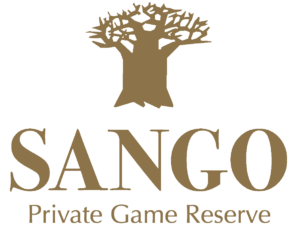PORTRAIT
Sango's Commitment to the African Wild Dogs
African wild dogs are endangered, and the second most threatened carnivore in Africa. At Sango, our emphasis isn’t just on showcasing these splendid creatures but on actively involving our guests in their conservation journey.
Encounter the Enigmatic Wild Dogs at Sango
With their distinctive coat patterns and agility, the African wild dogs are among Africa’s most mesmerizing creatures. At Sango, guests don’t just observe these animals but play a part in their conservation story.
Tradition Meets Technology in Conservation
At Sango, our conservation efforts go beyond traditional methods. The African Wildlife Conservation Fund works closely with Sango and assist with the monitoring and conservation of wild dogs across the Save Valley Conservancy. Jess Watermeyer, the Projects Director of the African Wildlife Conservation Fund (AWCF), elaborates on how, while traditional spoor tracking by experienced scouts remains a cornerstone, “there are instances where we utilize GPS collars to monitor specific high-risk packs that venture outside the conservancy boundaries or into areas where they face increased risks.”
Harnessing Technology for Enhanced Monitoring
“Our organization doesn’t rely on collars for monitoring,” shares Jess. “With our extensive network within the conservancy, many individuals report wild dog sightings which is a tremendous help to our efforts.” But she acknowledges the power of technology when she says, “in situations where the dogs are more at risk, we harness technology, including GPS collars. The strategically placed wildlife cameras throughout the region provide crucial data about these wild dogs. Every photograph captured is meticulously analyzed and incorporated into our comprehensive database.

10 Intriguing Facts About the Wild Dog
Equip yourself with these fascinating facts for your next wildlife conversation.
- Conservation status: endangered
- Scientific name: Lycaon pictus
- Weight: 18 to 36 kilograms (40 to 79 pounds)
- Size: about 1 meter in length (30 to 43 inches)
- Life span: 10 to 12 years
- Habitat: dense forest to open plains
- Diet: carnivorous
- Gestation: about 70 days
- Predators: humans and occasionally lions
- At Sango: guests actively partake in their conservation
The Precarious Position of the African Wild Dogs
As Jess form the AWCF emphasizes that these animals face considerable challenges, from habitat loss to human-wildlife conflicts. Yet, with Sango’s commitment and the active participation of our guests, a brighter future is conceivable.
An Intimate Glimpse into Wild Dog Behavior
Delving deeper into the life of the African wild dog, Sango offers a unique perspective. Their fascinating social dynamics, intricate hunting techniques, and the unmistakable painted coat, make them a captivating subject of study and admiration. Through our efforts, not only do we aim to conserve, but also to educate, offering guests an unrivalled insight into these remarkable creatures.

80% Success Rate: Sango’s Most Efficient Hunters
Wild dogs boast an impressive 80% hunting success rate, thanks to their teamwork. As you explore Sango, you may witness these exceptional hunters in action, a clear testament to the resilience of nature when protected and respected.
Experience and Contribute at Sango
At Sango, your safari goes beyond mere observation. Our guests delve deep into the world of wild dogs, learning about them and participating in conservation efforts. Your visit could see you witness wild dogs during special moments, like hunting impalas, or even participating in conservation activities. It’s not just a visit; it’s a meaningful contribution to a crucial cause.
4 Questions with Jess Watermeyer:
Sango’s Role in Conservation
Jess Watermeyer, Projects Director of the AWCF, highlights Save Valley Conservancy’s crucial contribution to wild dog conservation and Sango’s role as part of the landscape.

Jess, please summarize your vision for wild dog conservation and Sango’s role in it.
Jess Watermeyer: “Our main goal is to uphold a healthy wild dog population in the conservancy, with an overarching emphasis onsecuring space and connectivity for the animals. Given SVC and Sango’s proximity to places like Malilangwe and Gonarezhou National Park, there is potential for this. Wild dogs from SVC could help to repopulate other regions, but this hinges on collaborations to ensure their safe passage.”
How has Sango’s support been instrumental in your efforts?
Jess Watermeyer: “We deeply value Sango’s steadfast support in wild dog conservation and their in-kind support over the years. Their active participation, from reporting sightings to sending photos, supports the cornerstone of our monitoring. Sango always allow us access for our research work and is very supportive of our community education and outreach efforts. Sango, being the largest property in the Conservancy, naturally holds a significant place for these dogs.”
How do wild dogs perceive Sango?
Jess Watermeyer: “Sango, along with every property in SVC, is integral to the Conservancy’s ecosystem. Two wild dog packs denned on Sango this year, indicating its importance as a safe habitat in their territories.”
What are the challenges and prospects in ensuring wild dogs have ample space in the future?
Jess Watermeyer: “Our prime objective remains a thriving large carnivore guild and wild dog population within the conservancy, supported by a healthy prey base and functional ecosystem. Ensuring ample space for movement is key. With Sango and SVC’s strategic location, the potential for connectivity is promising. Our goal is to ensure wild dogs have the freedom to move, contingent on harmonious coexistence with surrounding communities. Achieving this will mark a true conservation success.”
Jess, thank you for your time, and best of luck and success with your work on the wild dogs!
More Sango stories
Previous
Next

